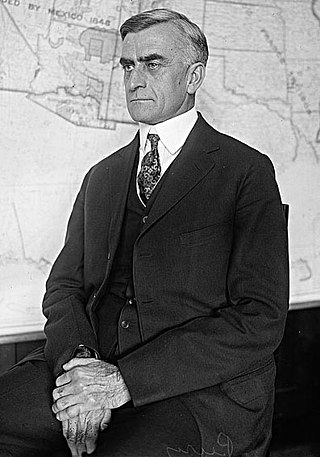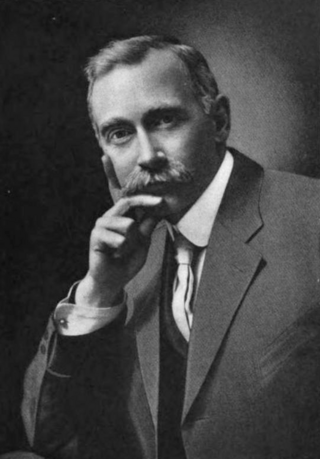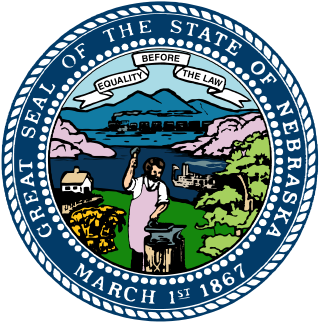
Edward Walter Gillespie is an American politician, strategist, and lobbyist who served as the 61st Chair of the Republican National Committee from 2003 to 2005 and was counselor to the President from 2007 to 2009 during the Presidency of George W. Bush. In 2012 Gillespie was a senior member of the Mitt Romney presidential campaign.

George Campbell Peery was an American Democratic politician, and was the 52nd governor of Virginia from 1934 to 1938. He became the second governor to be selected, at least partially, by the soon to be very powerful Byrd Organization, led by Senator Harry F. Byrd, Sr.

The 40th United States Congress was a meeting of the legislative branch of the United States federal government, consisting of the United States Senate and the United States House of Representatives. It met in Washington, D.C. from March 4, 1867, to March 4, 1869, during the third and fourth years of Andrew Johnson's presidency. The apportionment of seats in the House of Representatives was based on the 1860 United States census. Both chambers had a Republican majority. In the Senate, the Republicans had the largest majority a party has ever held.

The 41st United States Congress was a meeting of the legislative branch of the United States federal government, consisting of the United States Senate and the United States House of Representatives. It met in Washington, D.C. from March 4, 1869, to March 4, 1871, during the first two years of Ulysses S. Grant's presidency. The apportionment of seats in the House of Representatives was based on the 1860 United States census. Both chambers had a Republican majority.
The Massachusetts Republican Party (MassGOP) is the Massachusetts branch of the U.S. Republican Party.

Henry Floyd Samuels (1869–1948) was an American attorney, politician, mining executive, and farmer. He was the leading spokesman of the Idaho chapter of the Non-Partisan League and later the Idaho Progressive Party in the 1910s and 1920s.

The 2000 United States Senate election in Wisconsin took place on November 7, 2000. Incumbent Democratic U.S. Senator Herb Kohl won re-election to a third term by a margin of 24.5%. Herb Kohl defeated John Gillespie in a landslide despite Al Gore narrowly winning Wisconsin over Republican presidential nominee George Walker Bush in the concurrent presidential election.

The 1875 United States Senate election in New York was held on January 19 and 20, 1875, by the New York State Legislature. The legislature, with a Republican Senate and Democratic Assembly, jointly elected Democrat Francis Kernan Senator. Kernan became the first Democrat to represent New York since 1851.

The 1868–69 United States Senate elections were held on various dates in various states. As these U.S. Senate elections were prior to the ratification of the Seventeenth Amendment in 1913, senators were chosen by state legislatures. Senators were elected over a wide range of time throughout 1868 and 1869, and a seat may have been filled months late or remained vacant due to legislative deadlock. In these elections, terms were up for the senators in Class 1.

The 1874–75 United States Senate elections were held on various dates in various states. As these U.S. Senate elections were prior to the ratification of the Seventeenth Amendment in 1913, senators were chosen by state legislatures. Senators were elected over a wide range of time throughout 1874 and 1875, and a seat may have been filled months late or remained vacant due to legislative deadlock. In these elections, terms were up for the senators in Class 1.

The 2014 United States Senate election in Virginia was held on November 4, 2014, to elect a member of the United States Senate to represent the Commonwealth of Virginia, concurrently with other elections to the United States Senate, elections to the United States House of Representatives, and various state and local elections.

A general election was held in the U.S. state of Connecticut on November 4, 2014. All of Connecticut's executive officers were up for election as well as all of Connecticut's five seats in the United States House of Representatives. Primary elections were held on August 26, 2014.

The 1869 Vermont gubernatorial election took place on September 7, 1869. Incumbent Republican John B. Page, per the "Mountain Rule", did not run for re-election to another term as Governor of Vermont. Republican candidate Peter T. Washburn, who had served in the Vermont House of Representatives and as Adjutant General of the Vermont Militia, defeated Democratic candidate Homer W. Heaton, a former member of the Vermont House, to succeed him. The 1869 election was the final time the Governor of Vermont was elected for a one-year term; terms were changed to two years beginning in 1870.

The 1910 Minnesota lieutenant gubernatorial election took place on November 8, 1910. Republican Party of Minnesota candidate Samuel Y. Gordon defeated Minnesota Democratic Party challenger Merrill C. Tifft, Public Ownership Party candidate Lewis M. Ayer, and Prohibition Party candidate J. D. Engle.

Two special elections in Nebraska were held on November 2, 1954, alongside a regular election. The Class I election was to finish Hugh A. Butler's term, with Samuel W. Reynolds appointed to the vacancy on July 3, 1954. The Class II election was to finish Kenneth S. Wherry's term, with Eva Bowring as incumbent at the time of the election. Both seats were held by Republicans, with Roman Hruska winning the Class I election and Hazel Abel winning the Class II election.

The 1883 Massachusetts gubernatorial election was held on November 6.

The 1876 Colorado gubernatorial election took place on October 3, 1876, to elect the 1st Governor of Colorado after the state was admitted to the union on August 1, 1876. Republican John Long Routt, last governor of the Colorado Territory, was elected in a close race against Democratic nominee Bela M. Hughes.

The 1936 Iowa State Senate elections took place as part of the biennial 1936 United States elections. Iowa voters elected state senators in 32 of the state senate's 50 districts. State senators serve four-year terms in the Iowa State Senate.

The 1869 Ohio gubernatorial election was held on October 12, 1869. Incumbent Republican Rutherford B. Hayes defeated Democratic nominee George H. Pendleton with 50.74% of the vote.

The 1867 Iowa gubernatorial election was held on October 8, 1867. Republican nominee Samuel Merrill defeated Democratic nominee Charles Mason with 58.88% of the vote.





















